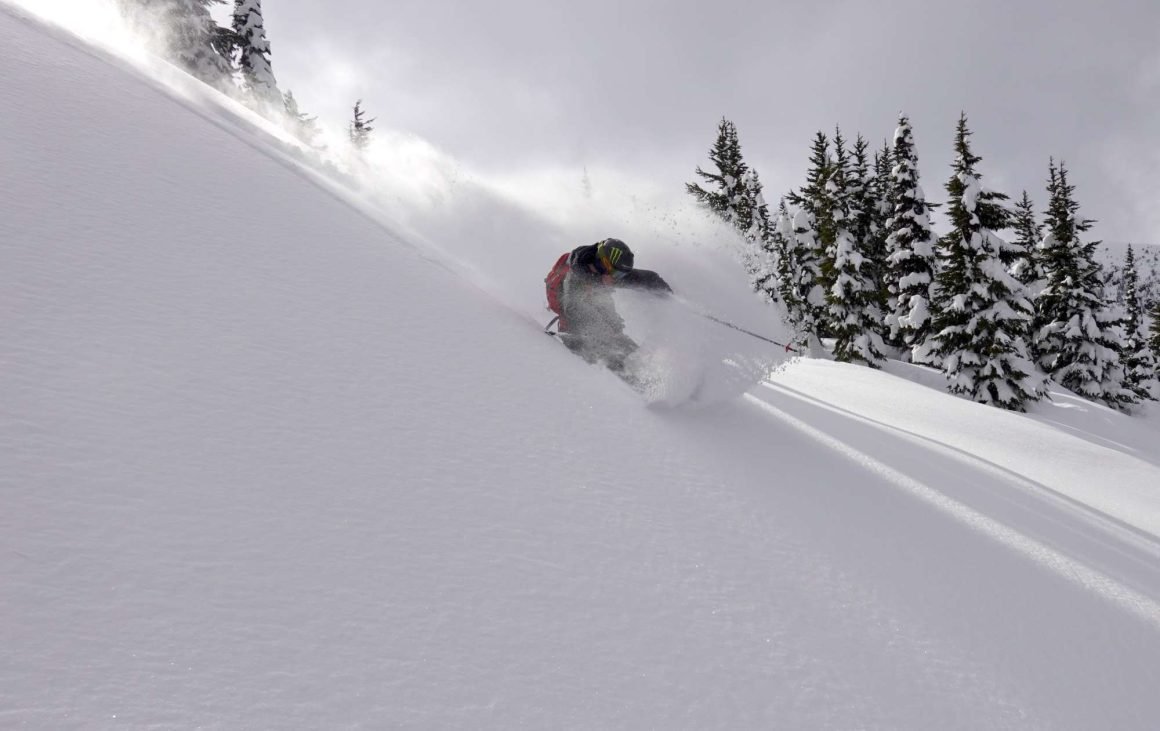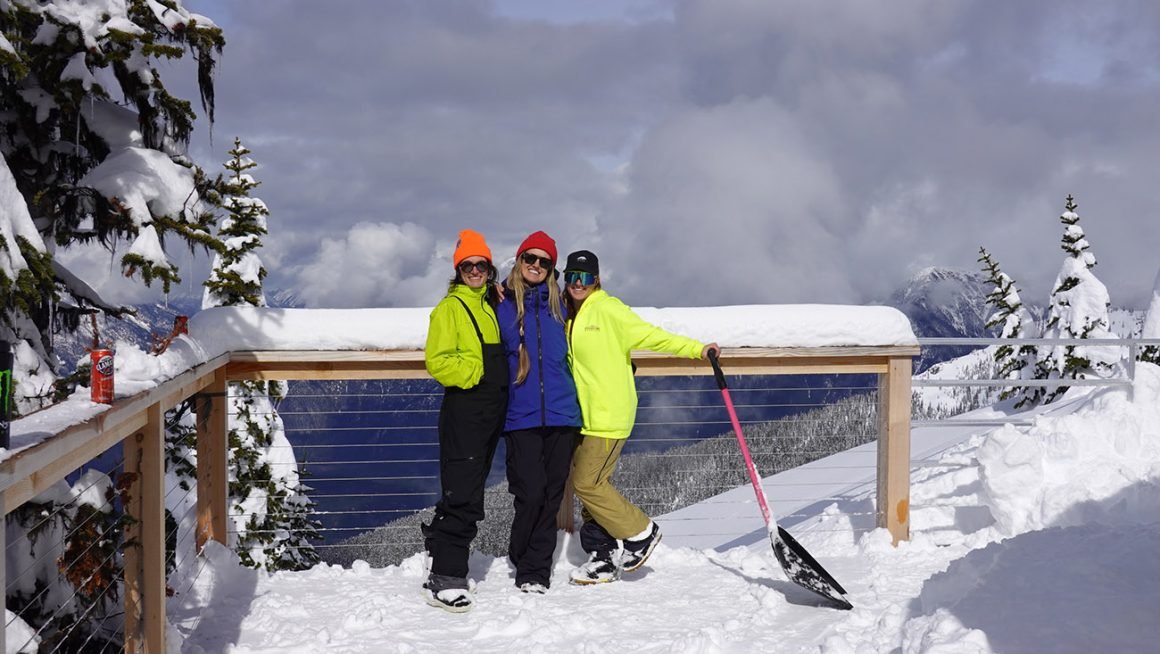Feet Banks | MountainLife: AlpX—Yurt The Ones You Love
Pow, laughs, and good bread at the South Coast Mountain’s newest backcountry basecamp
Originally posted on MountainLife
Words: Feet Banks
Stop me if you’ve heard this one:
Santa Claus, a penguin, and Clint Eastwood are hunkered down in an isolated backcountry yurt. Outside a storm is raging so they are spending the time playing cards and eating bread. It’s the best bread any of them have ever tasted.
“This reminds me of Mrs. Claus’ home recipe from the North Pole,” Santa says. “This bread must have come from the north.”
“It didn’t,” says the penguin. “I’m a bird and we know bread better than anyone. This bread definitely came from the south.”
“Listen, chumps,” Clint Eastwood snarls. “This is the best bread I’ve ever eaten, and everyone knows the West is the best, so that’s where this bread comes from.”
The three stop and stare at each other in tense silence. The vibe is so thick you could cut it with a (butter) knife when, suddenly, the bread speaks up: “You’re all wrong. I come from the yeast.”
Admittedly, this joke has nothing to do with ski touring, splitboarding, or spring in the Coast Mountains of British Columbia. But that’s kind of the point, because the best shred trips are about more than just the turns, the views, or the snow. Certainly, those are all nice but over time, pow-turns kinda blend together and one mountain sunset starts to mesh with the next in your mind. But good company, big laughs, great meals, and maybe a moonlight dance party or two…those memories last. The best trips are about the shared experience, the people you’re sharing it with, and the location in which it all goes down.
And this epic dad joke (in this telling at least) takes place in backcountry yurt, which is exactly where Rory Bushfield told it, whilst sitting at an eight-foot wooden dining table eating spaghetti with homemade moose/deer/chantarelle Bolognese sauce that we brought in a giant cooler, paired with wine from a bottle and very delicious garlic bread freshly heated on the gas fireplace of the newest and best ski-touring jump off point in the Sea to Sky—the AlpX Expeditions backcountry yurt.
Coast Mountain icons Blackcomb Helicopters created AlpX expeditions in 2022 as a single entity to focus on mountain adventure and tourism in the Sea to Sky corridor, Chilcotin plateau, and beyond. Planning for the AlpX yurt began shortly thereafter, though it took more than 18 months to bring the project to life. Tucked into the trees on a mountain ridge behind Ts̓zil/Mount Currie at 6000 feet (1829 metres) above sea level, the 24-foot diameter yurt is a veritable oasis of comfort and good times, with no shortage of alpine and treeline riding literally just out the front door. If life is only as good as the people you share it with, it certainly helps to be sharing it in a brand-new backcountry yurt.
Originating in central Asia, the yurt (or Gur in Mongolian) is a round, tent-like structure made of insulated layers (traditionally animal skins) that could house 5-15 people and be set up and taken down relatively easily to facilitate a nomadic lifestyle. Typically built with repeating geometric patterns (a lattice wall structure, converging roof beams) and held together with taught ropes or wires, the circular ceiling “crown” connecting all the beams is itself emblematic in many central Asian cultures, with roof crowns passed down from generation to generation.
In Western culture, the first yurt derivations were inspired by a National Geographic article on Mongolia published in the 1960s. The structure quickly gained popularity as wilderness basecamps/outposts and contemporary Western-style yurts are made of synthetic materials and, like the AlpX yurt, are often built to stay put and withstand extreme environments.
“The biggest challenge in bringing this yurt to life was definitely the weather,” says Andy Meeker, an 18-year veteran of Blackcomb Helicopters and one of the yurt project managers. “Weather and the tight timeline—up there we really don’t have that long of a building season between when the snow is melted and when it starts falling again.”
Transporting the materials and equipment required to build the yurt, deck, foundation, fuel system and composting toilet structure up into their alpine tenure required 25 heli trips from the Blackcomb Heli base at the nearby Pemberton airport. During cooler months, workers had to be flown in and out each day. And with an average winter snowfall of more than 38 feet (11.6 metres), some unique modifications were required.
“The deck is a timber-frame structure,” Andy explains, “with insulated foam decking beneath the floor and structure of the yurt. The yurt itself is built of two layers, a reflective roof fabric outer layer with a thermal insulating wall blanket hanging inside. We’re still bringing materials up, doing maintenance trips and tinkering with it based on feedback from people spending time up there. It’s always evolving as the environment changes from season to season.”
Built in cooperation with the local Lil’wat nation, as well as the Squamish Lillooet Regional District, the Village of Pemberton, and the Province of British Columbia, the AlpX yurt was also location-engineered to ensure it is safely positioned out of range for 100-and-200 year historical geological events (rockslides, avalanches, etc). Set amongst a ridgetop stand of fir and alpine hemlock, the delightful tree skiing available just one step off the deck is an added bonus.
That primo access to incredible snow and terrain is a huge draw for winter adventurers. So is the freedom of skinning for your turns at any pace you like. Unlike heli or catskiing, or even ripping the resort, with ski touring the only time you need to be anywhere is to catch the heli shuttle home at the end of the trip. That kind of peace, and freedom of pace, is rare in the mountains unless you’re tenting, snowcaving, or holed up in a backcountry hut hoping no other parties roll in. (Is there anything worse than a bunch of keeners arriving at a hut and trying to go to bed at 8 PM then rattling around at 6 AM when you’re trying to sleep? What’s the rush buddy?)
This kind of peace, and freedom of pace, is rare in the mountains unless you’re tenting, snowcaving, or holed up in a backcountry hut hoping no other parties roll in.
The other benefit of being self-propelled is the connection it creates to the terrain. Walking up a slope offers the opportunity to better understand the snowpack, to recognize potential problem areas, and to take the time to be as safe as possible.
Our yurt trip was scheduled just after a huge Coast Mountain storm that saw upwards of a metre of snow fall in three days. After a mind-blowing flight in from the Whistler heliport (flying past the face of Mount Currie cannot be put into words), Bushy, Stace, Claude, MC, and I arrived at the yurt on the front end of a warming trend to see that most of the alpine bowls had already slid. In safer conditions, skilled tourers with decent fitness could easily shred the alpine terrain surrounding the yurt for a week without skiing the same line twice (with 2650-plus acres of skiable terrain to choose from).
On this trip, however, a bit of extra caution was necessary and after some assessments and good group decision-making, our crew opted to start off ripping tree laps of firm, deep, untracked powder punctuated by sunny refreshment breaks on the yurt deck. Backcountry “camping” is a whole lot nicer with LED lights, a propane heater to dry wet gloves, a full kitchen for cooking pasta or chopping up charcuterie, and glasses to cheers Claude’s birthday champagne.
Similar to standard heli drops, it’s imperative guests to the AlpX yurt understand backcountry travel, self-rescue, have avalanche safety training and gear, and have filed a trip plan. You are on your own out there: act accordingly. (AlpX does offer a guided option as well, with a certified ACMG guide and/or proper safety equipment). The yurt sleeps six (though an A-Star heli only seats five guests) and the provided mats are super comfy—all you need is a three-season sleeping bag and your two favourite pillowcases. Drinking water is also provided, as is a two-burner stove/cookware and cutlery. Guests are expected to wash and dry all dishes, sweep/mop the floors, and generally leave the yurt in the same condition they found it. With one bar of cell service, the AlpX team are accessible by text if further instructions/clarification are needed, and you can even post sweet pow and high-five pics daily to help build jealousy amongst all your friends stuck at home.
Combining stunning alpine wilderness with the ability to get pow at your own pace and most of the comforts of home, the AlpX yurt redefines backcountry shredding. Certainly, heli and snowcat lodges are posher (and way more expensive) and backcountry huts can be good (if you’re lucky enough to be alone) but there’s a special kind of joy that comes with being out there at treeline in an amphitheatre of peaks and bowls with only your favourite friends and the call of the wild. As well, I don’t know of any snow caves or expedition tents that offer the ability to warm garlic bread, boil pasta, listen to your favourite Fort Knox Five dance mixes, dry your gear, and play Britney Spears Monopoly simultaneously. Bring your hut booties (and your favourite people)—the AlpX yurt is the best thing since sliced bread, from any direction.







